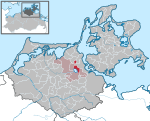Pütter See
Lakes of Mecklenburg-Western PomeraniaVorpommern-Rügen geography stubs

Pütter See is a lake in the Vorpommern-Rügen district in Mecklenburg-Vorpommern, Germany. At an elevation of 13 m, its surface area is 0.052 km².
Excerpt from the Wikipedia article Pütter See (License: CC BY-SA 3.0, Authors, Images).Pütter See
Langendorf-Pütte, Niepars
Geographical coordinates (GPS) Address Nearby Places Show on map
Geographical coordinates (GPS)
| Latitude | Longitude |
|---|---|
| N 54.2961 ° | E 12.99159 ° |
Address
Langendorf-Pütte
Langendorf-Pütte
18442 Niepars
Mecklenburg-Vorpommern, Germany
Open on Google Maps








